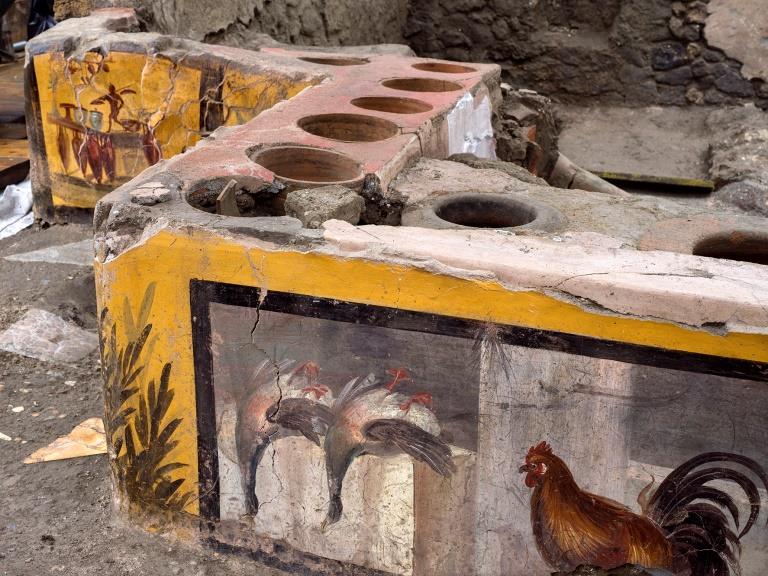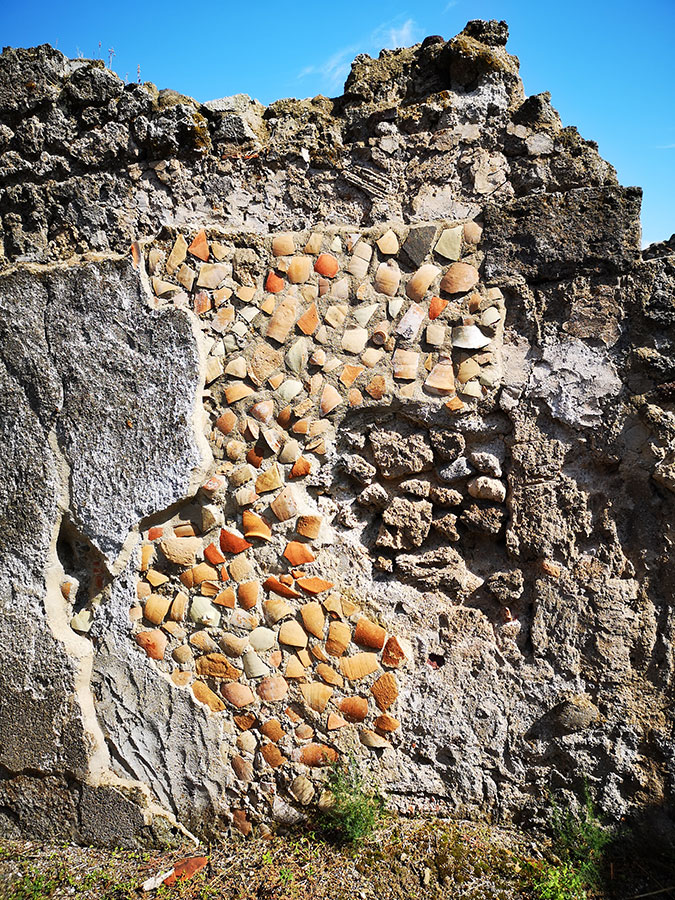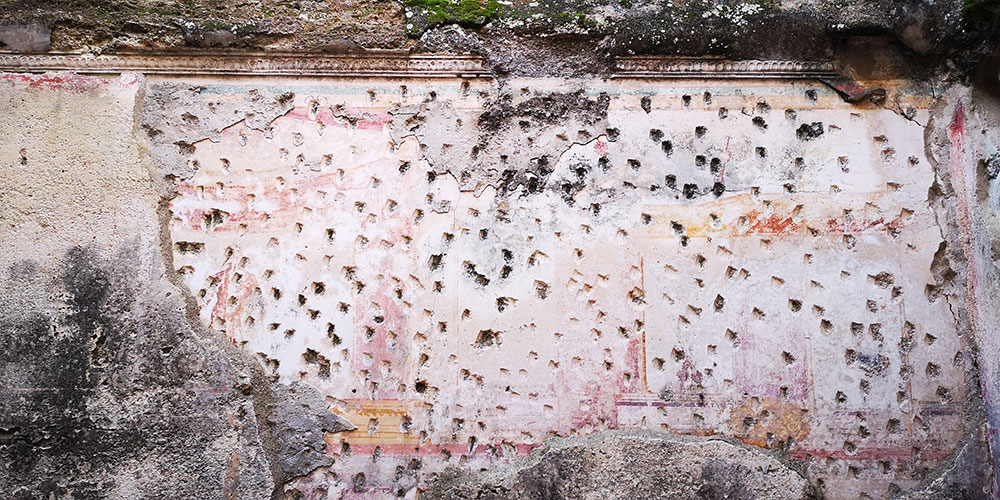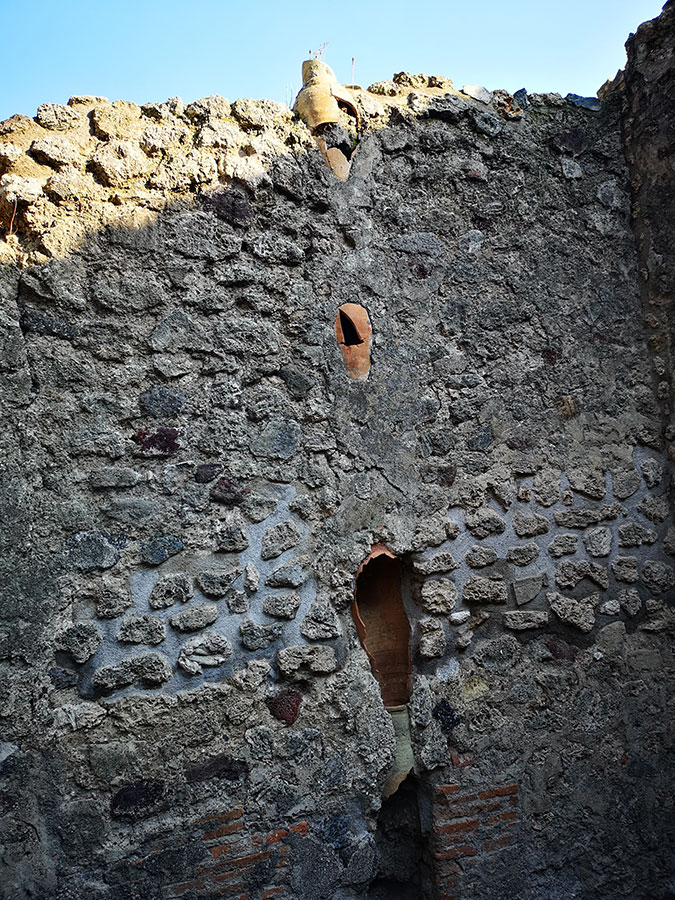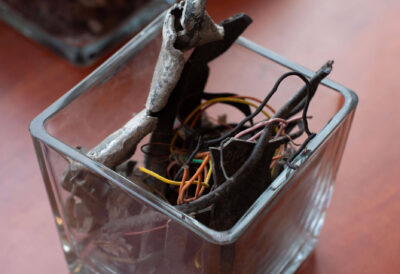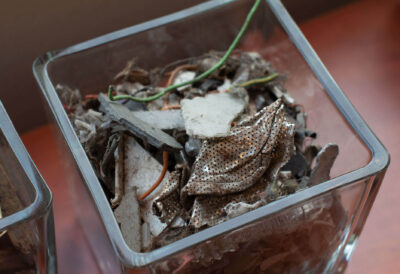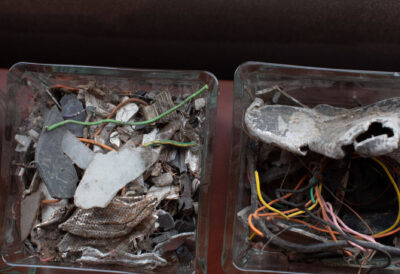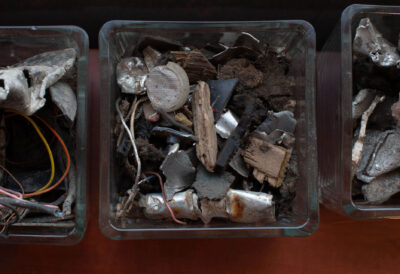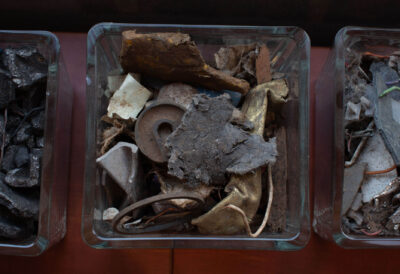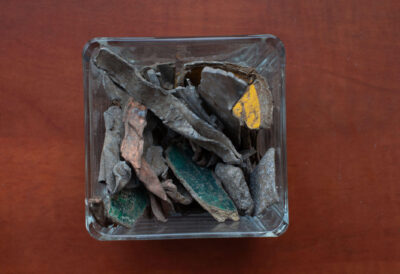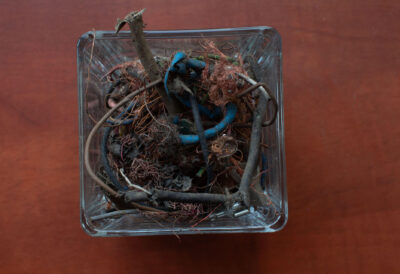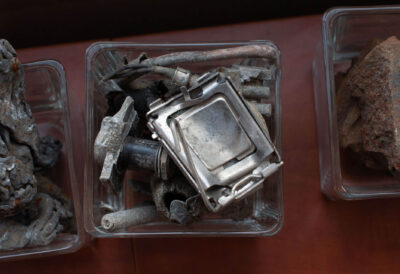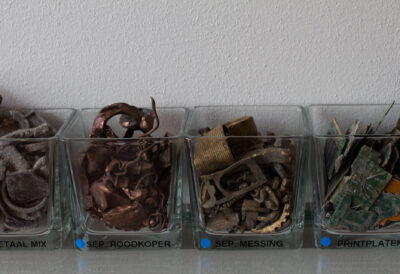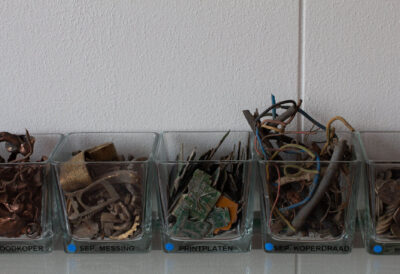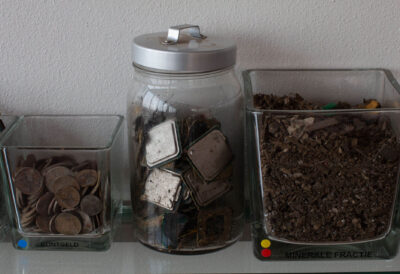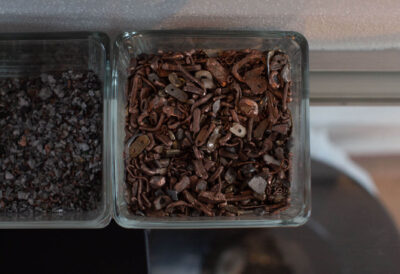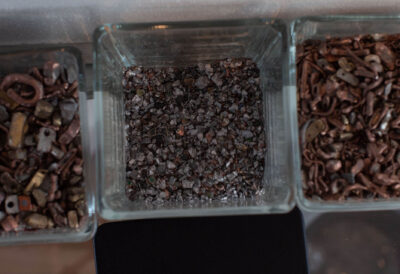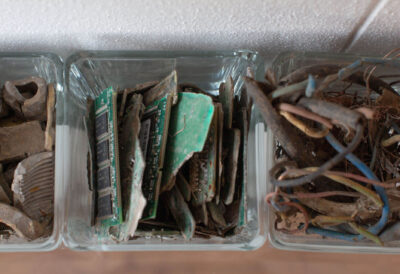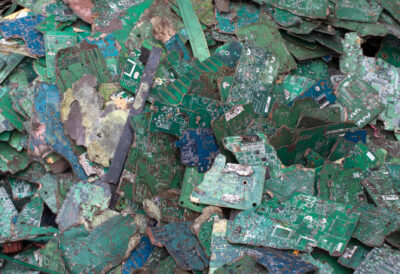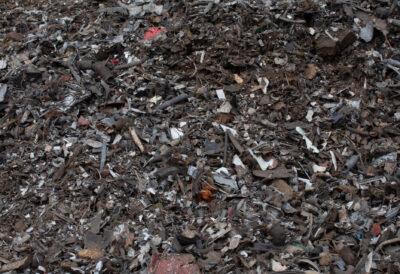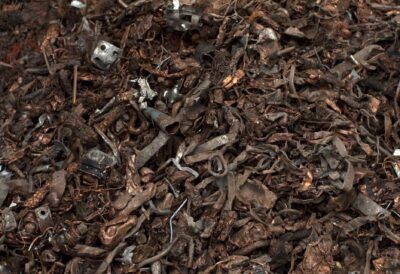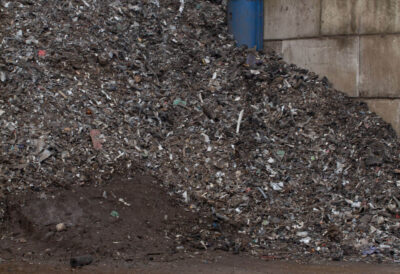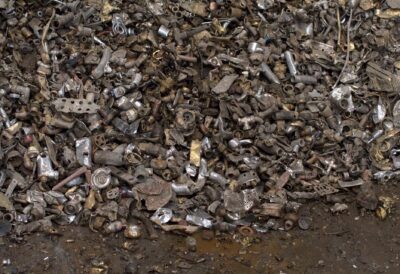Pompeii Commitment
Formafantasma. Recycling and Waste Management in Pompeii
Digital Fellowship 07 26•09•2023Formafantasma So, Marco, first of all thank you very much for making yourself available to have this conversation with us. Today we would like to talk with you, in the deepest sense, about matter as something in constant change, thus escaping the very idea of waste or leftover. When we talk about rejection, we have basically already decided what has a value and what does not. The moment we define an end of life for something, we no longer let it live its potential. We would like to talk with you about this concept, but with a very specific case study: Pompeii, which seems a great example of the idea of something that keeps living in constant transformation. I would first like you to introduce yourself, what background you have, but I would also like you to explain what you are dealing with in the context of Pompeii and how you found yourself involved in these themes.
Marco Giglio I am an archaeologist, graduated from the University of Naples “L’Orientale”, where I currently work as a researcher. I started working in various archaeological contexts and since 2004 I have been doing research in Pompeii, originally partaking in archaeological projects for L’Orientale, and later, from 2018 until 2021, taking part in a project focusing on a scheduled maintenance of Pompeii, which consists in taking care and working to anticipate the restoration phase, i.e. to preserve Pompeii without having to restore it. Because when carrying out a restoration, we are already making alterations, we are changing the ancient site. After 2021 I went back to my university, where I currently work, and started my own archaeological research projects in Pompeii, carrying out various excavation and research activities, as well as the studying and unearthing of portions of the ancient city, dealing not only with the Pompeii of 79 AD, i.e. of the last phase of Pompeii’s life, but especially with the building history of the older city, from its foundation in the archaic age, up to the arrival of the Silla colony in 80 BC. Moments – and this is relevant to the subject of our conversation – in which there were many transformations within the city, which however did not envisage the systematic creation of waste, but rather a constant reuse of matter. Material that may be reused in many ways within public and especially private buildings.
Formafantasma This is great, it looks like you have already got to the heart of our conversation. Before going further and talking about matter, I will take a small step back, which I think is essential to our conversation. When we talk about Pompeii, I believe it is important to also take into account the geological situation of the area in which Pompeii is located and the many earthquakes that have made the territory and the urban fabric unstable and therefore in constant transformation. I am obviously referring to Pompeii before the volcanic eruption that turned the city into the way we know it today. Could you tell us about the specific situation that typified the city, even forcedly, in continuous transformation?
Marco Giglio From a geological and volcanological point of view, the Pompeii area was quiet and safe for a long time. We do not know of eruptions or major earthquakes in historical times. The oldest, before the destructive eruption of 79 AD, dates back to around 2,000 years earlier. So there definitely was no memory of it, so much so that Mount Vesuvius was not even acknowledged as a volcano, but as one of the many mountains that formed the landscape. Only the last period of the city’s life, from 62-63 to 79 AD, was marked by a first major earthquake which caused extensive damage in the city and which we know from written sources, because it was also reported for Naples and other cities in the area, also heavily affected. From there, a vast reconstruction work started, which in turn was probably followed by other earthquakes that occurred over the years or in moments before the eruption of 79, the event that crystallized the life of the city, i.e. the exact moment that froze it in the way we later found it. The transformations, on the other hand, are mainly due to ethnic, socio-political and even chronological changes, so we could speak of changes in habits and customs, ways of living, food trends, trading contacts, which marked an improvement in the city life. The reinclusion into Rome’s orbit led Pompeii to access a commercial koine which allowed new materials and new wealth to flow in.
Formafantasma Let’s try to comment on the management of debris or waste in Pompeii from a contemporary point of view. You said earlier that it is difficult to make a perfectly reliable reconstruction of the reality of the city, because we can only base such reconstruction on the documents and artifacts that have been found. It is difficult to speak of the existence of a real waste management system, but at least could we say there was a figure in charge of that, do we know that such a role existed in the city, a person who was responsible for waste collection? Can you tell us something more about this and also tell us about the very idea of landfill, if it existed in the way we understand it today or if it had a different nature in the city of Pompeii?
Marco Giglio We must remember that we do not know Pompeii in its entirety, since only two thirds of the city have been excavated. So we can form an idea according to what has been brought to light, which is a lot, but in theory we could have totally different situations in the rest of the city. Moreover, we know well what is inside the city walls, while what is outside, the outer part of the city, we know nothing about. Therefore, we do not know if there were any collection points, landfills, material disposal points outside the urban area. And this is certainly a limitation. In addition, we must add that perhaps the vision we have of Pompeii in 79 is a little distorted by what had happened immediately before, i.e. by the great destruction caused by the various earthquakes that had hit the city and therefore by the great reconstruction that was underway: in fact, it is one thing to dispose of daily waste or small debris and another thing to free up an area where entire blocks had been damaged by collapses and were consequently undergoing extensive reconstruction. In this case, a totally different organized system is needed, with dedicated magistrates who have specific tasks for reconstruction. If we had to find a modern parallel, we could do it with what happens during post-seismic reconstructions still today. For archaeological research purposes, I lived the period of the earthquake in L’Aquila, where we worked for two months after the earthquake. Seeing the organization, the clearing of the rubble, the creation of temporary storage areas made me think about what the pre-eruption period must have been like in Pompeii, also as regards the social and economic rearrangement of the city. We need to remember that a large reconstruction building operation needs a large amount of manpower, which must be given food and accommodation. Perhaps this is one of the reasons why many Pompeii houses – a transformation again – in the last building phase become shops, restaurants, hospitia. When we think about it, Pompeii has a greater number of thermopolia, i.e. places selling hot food, than many other ancient cities. This is unusual, but we can probably trace it back to this phase of great transformation that was taking place in the city.
Formafantasma Of course, there was a need to cater and provide lodging for a workforce that was working on the reconstruction of the city. That’s exactly why I asked you the question about earthquakes. Because this historical period, characterized by a great earthquake and subsequent smaller ones before the eruption, produces a strong fascination as regards the sense of security that we experience in our time. It becomes an interesting case study of the reuse of materials and places. Earlier, you mentioned the fact that the urban fabric of the city changed a lot, precisely because of these traumatic events, but also because much of that material and debris, which we could partially define as waste or the outcome of a traumatic process, became actual elements in reconstruction. I think it is interesting to analyze this phenomenon, because it is a peculiar case study. We also see intersecting architectural styles, materials that are born with one function and are later reused in completely different contexts. There are two different levels through which we can approach this idea of waste and its transformation: there is urban waste, which is managed by a figure similar to the contemporary waste collector, and then there are various workers who deal with the re-management of architectural debris and more, due to the traumatic events of earthquakes. It is precisely from this point of view that it is interesting to analyze how the reconstruction was carried out and how these materials took on new functions. As far as Pompeii is concerned, we could actually speak of a recycled architecture, in the sense that the many reconstructions were actually carried out according to re-adaptations of existing materials and debris. I would like to imagine with you seeing a building of the city of Pompeii in section, and analyzing, starting from the foundations up to the upper layers of the buildings, how some of these materials came from previous buildings or from everyday objects and even how organic materials were transformed into building elements or used as foundation filler. I’m thinking of something you told me in the past, i.e. the discovery of organic waste under the foundations of an inn, in particular a quarter of an ox. Could we do this exercise together and analyze the building in section from its foundations up?
Marco Giglio Absolutely yes. We must look at a reconstruction phase as a moment in which it is necessary on the one hand to dispose of the collapsed materials, on the other hand to rebuild buildings, in some cases taking advantage of the circumstance to modify planimetries or expand them. There may be the case of a family fallen on hard times and thus needing to sell a housing lot to a neighbor who may expand it. Or there may be a need to totally modify the plan of a building, demolishing what was there before and rebuild from scratch, connecting floor plans and creating new fills and rises inside the building itself. This is the case of the new excavations that we have carried out along the Lupanare alley in the Stabian Baths tabernae, which had not been completed yet at the time of the eruption. Here there was essentially the need to obtain a floor entirely at the same level, which is why the older house was demolished up to floor level, thus obtaining a single platform on which to build the new walls, and this space going from 40 to 70 cm between the old floor and the new one was filled with debris. Oddly selected debris: generally we find little connected masonry, but above all loose stones, elements taken from old masonry of opus incertum, some plaster that was probably minced and reused as mortar, very few tiles, because usually these roofing systems could be cut getting rid of their lip and transformed into bricks to redo brick walls found throughout Pompeii in the final phase of its life. In this case, there are also several animal quarters, something rather unusual which we are unable to explain: perhaps they were leftovers from a slaughterhouse, disposed of and hidden under and inside the floor? We are still debating this, but what is certain is that it was a sort of landfill in the city. A waste disposal, in this case of solid urban waste, which was hidden or reused in the filling together with many other materials. We should not forget that building material is always reusable. Ancient building material consists of lithic material of various kinds. In Pompeii we have the limestone from river Sarno, lava cruma, lava and tuff from Nocera: four lithic types of different origin and different resistance to loads, different weights, different age, which however can be reused in various ways even later, as done with bricks. All this emphasizes the need for building debris. Old plaster can serve as an aggregating agent, once it’s been crumbled inside mortar. There is no much use for ceramics. Amphorae can in theory be transformed and reused, meaning that, except for organic materials, there are not many elements that become real, unusable waste…
Formafantasma Exactly. We are dealing with a very limited palette of materials, which cannot actually become waste because they can be easily and repetitively reused. What is interesting on an architectural level is that there are examples of material usage shifting, because the material palette is relatively small. I am thinking, for example, of terracotta amphorae reused as water pipes, both underground and as gutters. The most interesting thing is that there is a shift of function, but the object, the materiality of the object, allows this type of immediate reuse. So there is a continuous shift of function, also due to the fact of having a fairly small range of materials available all in all – few but decidedly flexible in their reuse. I am also thinking of some ornamental and sculptural elements that change over time and are recontextualized by combining different styles. Can you give us some examples in this regard?
Marco Giglio An example could be in a structure located in Regio IX, insula 6 in Pompeii, a totally new wall built after 62, after the earthquake, which defines a new space inside the building. At first glance it looks like a brick wall. Brick walls usually have totally flat planes. And that’s what you see in the lower part of the image. But if you observe carefully, in the upper part you can instead see an irregularity in the wall texture, which is bulging. This is because all the masonry is made of fragments of large foodstuffs containers called dolia, which were broken into pieces and reused as building material. I believe this is an outstanding example of the ability to reuse material in antiquity. In this case they had vases, which were broken, crushed to small pieces and reused as wall facing. In the end, all of this would have been invisible, because totally covered by plaster, so there was no difference between using new bricks or recycled elements.
Formafantasma This is where the idea of the material as an element in constant change is clear. Material being regenerated and turned into something else. It is not waste, but simply matter that is read for what it is and as such can be reused in a very direct way. It is the same thing that happens, as we said before, with amphorae used in guttering and underground water distribution systems.
Marco Giglio I will show you another example. Here you have a boundary wall of a built-in closet in a house in IX.7, 21-22, again made after the 62 earthquake and thus pre-eruption. As you can see, it is difficult to define the masonry technique, because there are white limestone stones, lava stones, Sarno limestone, lava cruma, a variety elements implying that once again they were recycled materials. There are also bricks and, on the right edge of the image, two gutter tiles, i.e. two gutters, two drips. In the upper one you can still see the palmettes that decorated the gutter and probably the mouth of a lion’s head that served as a drip, while the lower one is a little simpler. They are two stylistically different elements, which presumably previously decorated the perhaps damaged peristyle or atrium of another Pompeii house, which the owner of this new building acquired, recovered and reused within the masonry. Hence, these elements, from an ornamental and functional function, i.e. that of gutter, become plain building material.
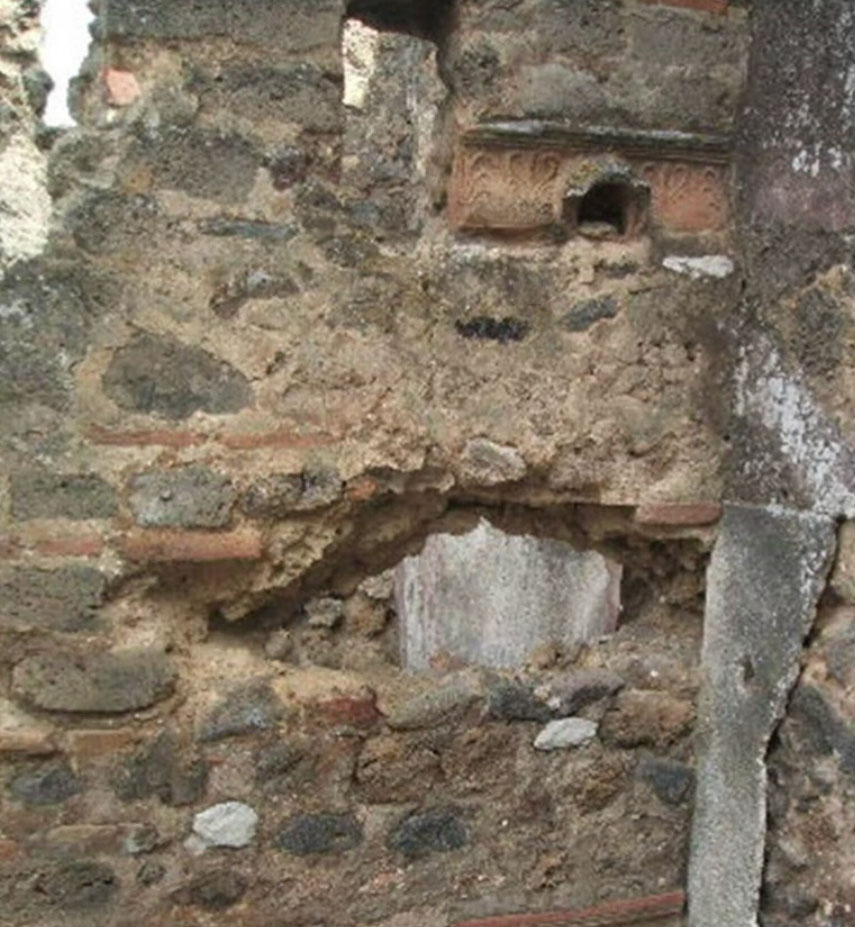
Delimitation Wall Made with Recycled Materials, approx 62 AD, Pompeii, IX.7, 21-22, Pompeii Archaeological Park. Courtesy Marco Giglio
Formafantasma This form of reuse and recycling also extends to decorative elements, which retain their ornamental function. Perhaps sculptural works are transformed and adapted over time to become new sculptural elements, in which the author works on top of an existing work.
Marco Giglio I am thinking of the case of the Orion mosaic. Among the new mosaics that were found during the excavations in Regio V in Pompeii, which have become very famous for the richness of their decorations, there are these two so-called Orion mosaics, because they depict the Orion myth. It is a mosaic in polychrome tessellate which was inserted at a later time within a floor with a totally different ornamental motif, in opus signinum with white dots. If we observe carefully the decoration scheme of the dotted lines, we notice it is not related to the mosaic, but rather to be interrupted by the mosaic itself. This probably means that the mosaic was either inserted after the floor was made, because it was purchased and reused in the decoration of the house during an upgrade, or it is once again the result of a space being transformed. This type of transformation is very frequent. They can be of a more complex kind, as in this case, with the insertion of mosaics which, among other things, depict a very complex and rather uncommon myth, or they can be simpler, as in cases where a floor is redecorated by inserting polychrome marble tesserae, creating a new ornamental scheme and embellishing a stylistically old but still desired covering.
Formafantasma Sure, also because the ornamental schemes and fashions were not short-lived like in current times, but had a decidedly longer life. There are ornamental schemes that remain unchanged for 200 years and then change, perhaps forcibly as a result of traumatic events, such as an earthquake, after which reconstruction pushes towards the transformation of different styles.
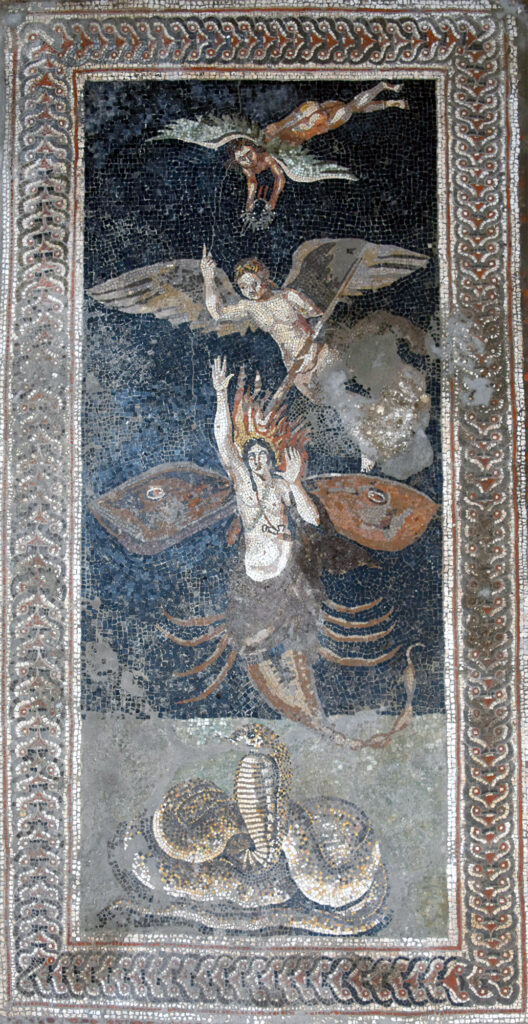
INVENTARIO 10 — Orion Mosaic, late 2nd BC – early 1st BC, mosaic, Pompeii, House of Jupiter (V) Archaeological Park of Pompeii. Photo Pompeii Archaeological Park

Marco Giglio But in some cases we also have conservation, we could almost say the restoration of an ancient style. For example, in the House of Epidius Sabinus, which preserves a First Style peristyle, therefore with a decoration almost 200 years older than the time of the eruption, a portion of that decoration was redone in the same style. We do not know exactly when, but it was redone that way as to maintain the unity of the First Style. It must have had a symbolic significance for the owner of the house that he chose to maintain the specificity of the old decoration up to 79. As if we, living in a fifteenth-century building, decided to keep all the original decorations. Let us think of the emblematic case of the House of the Faun, which reached 79 unchanged, or almost, in its decorations for 200 years. Instead, we also have many other examples in which either due to constraint, damage, or totally new stylistic choices, the decoration got changed.
Formafantasma Sure. On a historical level, would you define stylistic and temporal cycles or is the situation much more organic? I am asking this question because I am thinking of Roman pottery, in which it is possible to distinguish two periods, one featuring reddish pottery and one black pottery, both lasting around 500 years. Can you make a similar comparison also for Pompeii or is the issue more complex?
Marco Giglio In terms of ceramics, as you said, we are in a situation of koine and globalization. Except for differences in the place of production, the ceramics you find in Rome, Neapolis, Pompeii or the Marches, as well as on the Germanic limes, from the Augustan age onwards, are in fact the same. Basically, there are large production centers that export the same products more or less throughout the Mediterranean basin. From an archaeological point of view, this is very useful, because we have a way to cross-date between one site and another. As regards decoration, Pompeii has allowed a subdivision into four specific styles, which correspond to as many well-defined chronological moments, i.e. the moment of creation and first use of each of these decorations. Of course, their duration over time may vary, but we know that between the end of the 2nd century BC and the beginning of the 1st century BC, the First Style spreads. The Second Style coincides with the period following the creation of the Roman colony, up to approximately the Augustan age, i.e. the end of the 1st century BC. The Third Style goes from the ’30s of the 1st century BC to the late half of the 1st century AD, approximately the period immediately before the earthquake. The Fourth Style is that of the last phase of Pompeii’s life. These elements are also useful for outlining a history of the buildings being worked on. These correspond to fashions that spread in the city, which we can study well in Pompeii and Herculaneum, because here we have an exceptional state of conservation. However, in one of our recent excavations carried out in a temple in Cupra Marittima in the Marches, we found pictorial and ornamental material from the Augustan and late Augustan age, similar in many ways to the decorations found in Pompeii houses. This means that once again we are faced with an ornamental koine throughout the Romanized world. And once again, also as regards building techniques, the creation of vestments, there are technical differences that correspond more or less to different times.
Formafantasma I would like to go back to the house we referred to earlier, the hypothetical architecture to be analyzed in section. And I would like to talk about where the building material came from and how the house was built. Specifically, I am referring to the pozzolan and the construction of extractive wells directly in the center of the house and then to the role of debris to close that extractive well around which the building was erected. It seems to me a very interesting idea of a ‘here and now’ building approach. An extraction well is dug, the house is built around it and then the well is filled up with debris.
Marco Giglio We must think that below the floor levels of Pompeii there are eruptive basins, an eruptive stratigraphy made up of cinerites, essentially pozzolans, therefore extremely useful material in the creation of mortars. Now, in the rooms of many Pompeian buildings rebuilt after 62, after the earthquake, we have found very large and deep pits (in many cases we have not been able to dig them completely), which intercept the eruptive levels, going down 2-3 meters in depth and covering almost the entire surface of the environment in which they were dug, which are filled with building debris, ceramics and waste material. Their function was probably to create the extraction well for the building material, the pozzolan, directly in the place where the work was to be carried out, greatly saving on two extremely costly factors in a construction site: the supply of the material and its disposal.
Formafantasma In fact, I believe that the financial aspect is central here, that there is a kind of design economy linked to the disposal of debris, to the construction of building.
Marco Giglio In a reconstruction moment, we must definitely take into account the existence of large public construction sites. Let’s think in some cases of the facades along the main roads rebuilt after the earthquake, which are all similar in the techniques used, implying a possible public reconstruction contract. But then there are the large private enterprises, in which case it is the economy of the single family that must bear the brunt of the reconstruction.
Formafantasma Do you think this attitude towards reuse also generates a certain informality and flexibility in private spaces? Or rather, perhaps the precarious condition after the first major earthquake and before the eruption also led to this fluctuation of the urban space? I am referring to how architectural elements that belonged to a domestic nucleus are sold to another family or how the opening of a door or gap between one structure and another may connect two buildings, transforming them into a new residential nucleus. It seems to me that this phenomenon is quite visible at an urban level in Pompeii.
Marco Giglio It is extremely visible, but it is something that already starts in the pre-earthquake phases. We already have transformations with a much more marked spatial shifting compared to the one we have in the modern era, where you can witness the subdivision of a large apartment into two or more apartments, or the union of two apartments, two different cadastral units. We rarely see, for example, the purchase of a neighbor’s living room and therefore such a clear-cut transformation of the floor plans of a building. While instead in Pompeii this is a phenomenon that we see very often, i.e. transformations that can take place either in the organization of internal spaces (doors that are closed and opened in another position), or in the sale of portions of houses, or even in the union, without demolishing them, of several housing lots, connected by newly created spaces. And all these transformations are clearly legible in the wall texture, which retains all the traces of the modifications made: door openings, closures, window openings, room moving or subdividing through the creation of new partitions, or the demolition of walls, with those that were, for example, a corridor or a room that becomes a larger room because the wall of the corridor is knocked down and the communicating doors are also closed. If you go around Pompeii in areas where the ornamental apparatus did not survive, you can clearly read these transformations, remembering instead that all the transformations from older times were not visible, because everything was always covered with plaster, hiding the changes.
Formafantasma As a person who deals with design in the contemporary era, I could easily think of that as an almost romantic reality, where people lived in a kind of community in which they were willing to give up space and have a more organic and less defined urban layout, perhaps less founded on private property than today. Am I romanticizing the past or was there actually a more informal management of private property, on a much more human scale? Or was this informality simply part of an urban regulation system?
Marco Giglio This is a very complex question. It touches areas that are not exactly those of an archaeologist…
Formafantasma We will point out in the interview that you are not an expert on this, but you may want to expand anyway.
Marco Giglio There definitely was a strong presence of private property, with a regulation for spaces, as well as the care of public areas by the private sector. The private individual took care of the facade of the house and the sidewalk in front of it, and for this reason we also see many changes in the sidewalk type. So there was a strong private component, and within the houses there was a strong private management component. However, there was probably less rigidity in the concept of exchange within private property. That is, I imagine that if you needed to expand, you could take advantage of the neighbor, either because he was a family member of yours (we do not know how many lots were owned by the same group of owners), or because he was facing hard times and therefore reduced and transformed his business, his home into business premises, or no longer needed those spaces and sold them. But this is an area in which I can only speculate. I am more used to reading traces to build hypotheses, so I will not go any further.
Formafantasma What you say about the management of the facade and the sidewalk seems interesting, because this obviously means that at an urban planning level what we are faced with is also a sort of constant evolution of a collage of different realities that are seen not only at the facade level, but also at a road surface level, implying sidewalks of a certain type, perhaps even ornamental in quality, and others instead perhaps more ordinary and associated with less well-off families.
Marco Giglio Absolutely. Among other things, we have clear signs of the boundary of a property because every now and then cornerstones, space-markers, elements that define the space of one property over another, even outside the houses. For example, the stretch of sidewalk in front of the House of the Faun is different from that of the neighboring buildings, if only for the welcome inscription in front of the house entrance, which is indeed a sign that the owner could customize a public space.
Formafantasma I believe that in this conversation you have given very interesting examples of waste and debris reuse, both for the building of foundations, as in the case of amphorae reused as gutters, or of the use of terracotta shards for the construction of masonry systems. Do you have other examples you would like to mention that you find fitting or particularly striking of material reuse? I am thinking, for example, of sculptural materials such as marble, which transform themselves from an ornamental and sculptural object into a structural building element.
Marco Giglio In many cases we have elements of white limestone reused within the walls as portions of material, and in those cases it is certainly material that had another function. It may be a marble slab that simply cracked, in which case there are two possible reuse options: it is either transformed into lime or the fragment is reused tout court within the masonry. There are many such examples. More than the reuse, the technical choice of the material that was made in the reconstruction is also interesting. As I said, we have various lithotypes used in Pompeii: one of these is lava cruma, which is essentially a very porous surface lava, red in color, resistant and very light. Very often the upper floors of buildings are built entirely of lava cruma, because it was understood that it was better to put the heavier material at the bottom and the lighter at the top. I do not want you to think of a chaotic reuse of the material. On the contrary, these are extremely thought-out and organized construction sites, where resources are optimized as much as possible.
Formafantasma Yes, that is clear. If a person has been to Pompeii, it is obvious to them that there is nothing chaotic in the architecture, but rather everything is pretty well organized, at an urban but also structural level. What strikes me as a designer, even if I do not deal with architecture, is the way in which materials change in their function, and the fact that building techniques allow for this constant transformation of materials. If I think of contemporary architecture, it is unthinkable to build in this way.
Marco Giglio Definitely not an option in contemporary architecture. In theory, you may make a partition by reusing materials, even different ones. But currently it is much simpler and cheaper to make something in reinforced concrete, a fluid material…
Formafantasma Or with a prefabricated material, which however does not allow reuse. In both cases, among the types of architectural building, the reality we observe in Pompeii was not based on a form of idealism linked to reuse, but was a form of design economy, of real cost-conscious design. The same is done in the contemporary world, in which though it is less expensive to pour concrete or use prefabricated element in building.
Marco Giglio Cheaper in the short run, but not in disposal.
Formafantasma Precisely. This is exactly the point I wanted to get to. In an economy of the total project, in some way the design of Pompeii’s architectural urban space could be a sort of model in contemporary architectural building. I am thinking of the contemporary need of finding construction systems that are above all more localized, without the need to bring materials from other places, and that make the cycle of architectural production more inclusive of the end of life of this architecture and its regeneration, which shows in the building approach of the city of Pompeii more than in the way building is carried out in the contemporary world.
